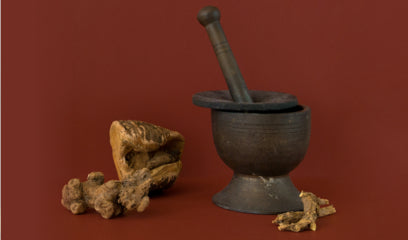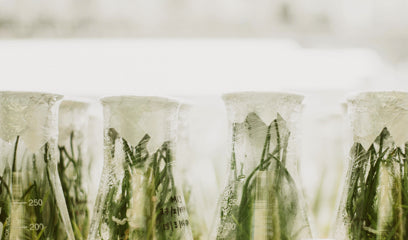Species Authentication
The purpose of Species Authentication is to determine the correct origin, species, and quality of raw materials. This assessment is performed to prevent the use of mistakenly identified herbs or the substitute of imitation products.
Our raw materials go through 4 key authentication steps:- Appearance - Experts determine the species by the herb’s exterior characteristics: color, size, scent and texture.
- Microscopic identification - Laboratories use a microscope to determine the herb by its unique characteristics observable only under magnification: the grain of cross-sections of the herb, the graininess of its powder, its cell shape and its behavior under chemical dissociation.
- Physical and chemical identification - Laboratories determine species by its unique characteristics under a battery of chemical and physical tests: appearance under fluorescent light, performance under distillation, color chromatography, spectrometric analysis, lost weight on drying, ash content, percent of insoluble ash
- Chemical fingerprint - this method does not seek to identify the exact chemical structure from analysis, but rather seeks identical matches of each batch of the same herb to a laboratory standard. We use the following analytical technologies to obtain chemical fingerprints: Thin Layer Chromatography (TLC), High Performance Liquid Chromatography (HPLC) Chromatography, and Gas-Liquid Chromatography.
In order to guarantee the efficacy and quality of each herb, we employ expertise both in traditional methods of inspection of an herb’s exterior surface, color, grain etc., as well as analytical methods made possible by state-of-the-art modern advancements in science.
Pesticide Residuals Detection
Chemical pesticides can be generally classified into 4 types: organochlorine, organophosphate, carbamate and pyrethrin. Though organochlorine pesticides are most harmful to human health and are strictly forbidden by law, they continue to exist in some environments due to their persistent nature. The process for detecting pesticide residuals includes not only the chemical compounds within the fertilizer, but also the resulting chemical compounds produced as a byproduct of chemical reactions within and on the surface of the plant. So when detecting pesticide residuals, we test not only the chemical compounds within the fertilizer, but also the potentially harmful chemical compounds produced as a byproduct of chemical reactions within and on the surface of the plant.
The scientific processes typically used to detect for pesticide residuals are typically TLC or gas chromatography. We insist on using the latter because of its higher sensitivity and more precise and reliable results.
Heavy Metal Detection
Herbs have been used in China as medicine for thousands of years. In the pre-industrial past, these herbs grew freely in pristine nature without any danger of contamination by pesticides or other environmental pollutants. The presence of small amounts of naturally occurring heavy metals in the herbs was never a cause for concern. But in today’s modernized society, farmers liberally use pesticides and pesticides on their crops, while industry-caused pollution, such as acid rain and factory-produced wastewater, can damage and dangerously alter the nature of the herbs. For every herb, there are 5 heavy metals that pose the most potential damage towards human health:
Lead
Contains toxins destructive to the nerve system and can cause brain and blood disorders. It interferes with a variety of body processes and is toxic to many organs and tissues including the heart, bone, intestine, kidney, and reproductive and nervous system.
Copper
Although essential to human health, in high concentrations causes nausea, vomiting, stomach cramps, diarrhea, epilepsy and in some cases even proves fatal.
Arsenic
Contains carcinogens and the toxicity of inorganic arsenic compounds can affect skin tissue (such as skin lesions, the mucous membrane, the endothelium) and the nervous system, causing headaches, confusion, severe diarrhea, and drowsiness. Furthermore, arsenic can accumulate in granular glands and fundamentally change the membrane’s structural and biochemical functions. The organs most affected by arsenic poising are the lungs, skin, kidneys, and liver.
Mercury
Affects the nervous system and can lead to all kinds of brain and kidney problems.
Cadmium
In the body has a very long half-life (over thirty years), and accumulates within the organs over time with no known effective treatment to expel it from a person’s system, making our prevention procedures even more critical. Ingestion of any significant amount of cadmium causes immediate poisoning and damage to the liver and the kidneys.
We use ICP spectrometry analysis to detect for heavy metal content in herbs, providing a much more accurate measurement than techniques outlined in Chinese Pharmacopeia. We maintain quality standards under which we would proudly consume our own herbs. With every new survey of reference material and current literature on heavy metals detection standards, we always adjust protocols in favor of more rigorous factory standards to guarantee that our herbs - from initial ingredients to finished products - are free from heavy metal residual pollution.
Sulfur Dioxide Detection
The vast majority of Chinese herbs derive from natural plant, animal and mineral products. Herbs, like any natural product stored for an extended period of time, become vulnerable to mold and insect infestation. It is common for mainland Chinese herbal farmers to use a sulfur-based fumigation process to control decay from insect infestation and mold occurring in herbs stored for long periods of time. It also serves to exterminate existing pathogens. Sulfur cleans the raw herbs, clearing away excess skin, even in closed, unexposed spaces. Burning sulfur for fumigation provides an efficient method to simultaneously exterminate harmful insects, bacteria, and prevent insects and mold.
Use of sulfur dioxide and alkali produces inorganic sulfites, and ingesting these sulfites can cause harmful health side effects in people, such as diarrhea, allergic reactions and asthma. The FDA has long designated sulfites “generally recognized as safe (GRAS)”, and it is widely used to preserve the clarity of white wine and as a preservative in fruits. But for food products containing sulfite residues exceeding 10ppm, the FDA regulates that a warning must be declared on the label.
There are a few ways to detect for sulfites, including by aerated-oxidization, iodine titration, atomic absorption spectrum and direct color comparison. We use the government-approved Rankine Method for residue analysis, also known as the alkali titration method. The principle behind it is to place the herbal ingredient with the acid and then distill it, absorbing the SO2 into the oxidized H202. After sulfuric acid is produced, an alkali titration method is used to detect for sulfite residues. Olive green signifies an absence of oxidized sulfur residue. A purplish-red color signifies the presence of oxidized sulfuric residue.
Aflatoxin Detection
Aflatoxins typically reside in pesticides, soil, hay, preserved products and animal organs. Aflatoxins thrive in a temperature range between 77~86°, a relative humidity above 75% and a pH level above 5.6. Scientists have discovered four kinds of possible carcinogenic aflatoxins produced by the aflaorganism Aspergillus flavus, and classified them into B1, B2, G1 and G2 categories. Presence of Ochratoxin A has been detected in numerous commodities such as rice, grain, peanut, corn, vegetables, and coffee. In order to keep the herbs from metabolizing the substance’s toxic byproducts, KP must analyze the herbs’ raw materials for the volume of Ochratoxin A. By doing so, we can guarantee the herbs’ raw materials safety for consumption.
Aristolochic Acid Detection
Aristolochic Acid (AA), a chemical compound in many commonly used herbs in the Artistolochiaceae plant family, is deemed a toxic substance as it has the capacity to mutate into a carcinogen. While misidentifying or mistakenly substituting ingredients can be harmless, it has proven to be detrimental under certain circumstances. Regrettably, AA is present in many of these misidentified herbs.
For nearly 30 years, we have promoted research and vigilance towards the serious dangers of erroneous identification of herbs and inauthentic herbal products on the market. Our facility adopts a zero-tolerance policy regarding the presence of AA. Additionally, we are especially vigilant toward those herbs that can be easily confused with AA - Stephania tetrandra, clemantis armandi Franch, Vladimiria souliei. We perform TLC analysis and HPLC analysis to distinguish the authentic herbs from the common substitutes and maintain an inflexible, uniform policy forbidding any ingredients tainted with the presence of aristolochic acid.
As our commitment to your health, with every new reference material regarding regulation standards, we always adjust our protocols in favor of more rigorous standards. Though the acquisition of high-precision instruments, talented researchers and the implementation of new testing processes come with increased operating costs, they represent steps taken towards a firmer guarantee on our products’ quality- from raw ingredients to finished goods. We see it as our responsibility to safeguard your right to safe supplements and to improve our society’s general well-being in an environment of growing uncertainty.










